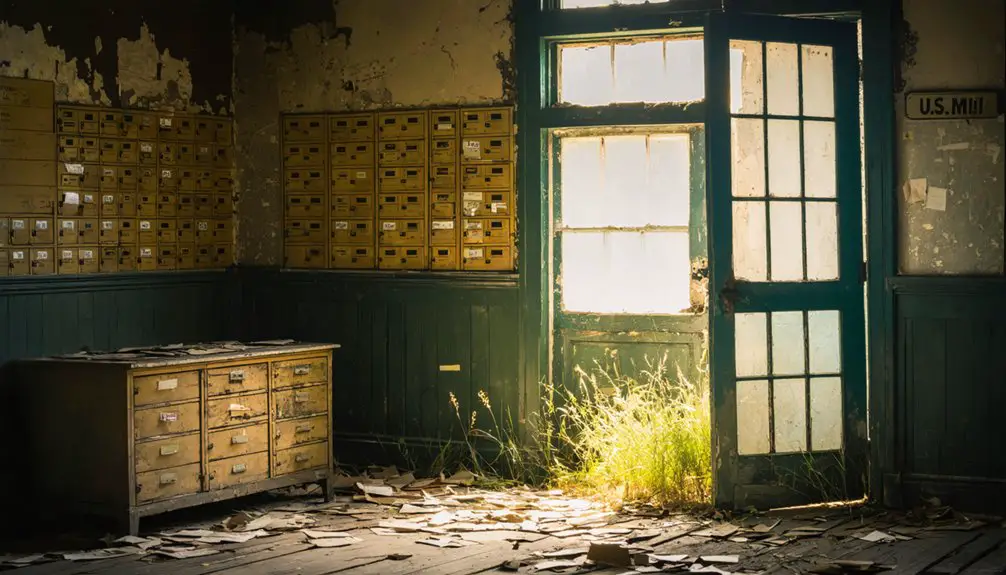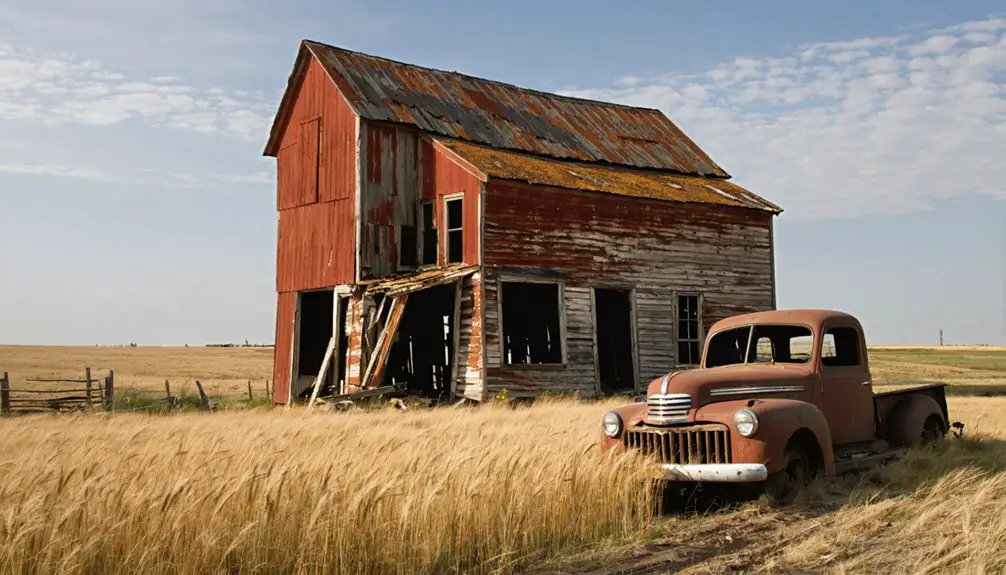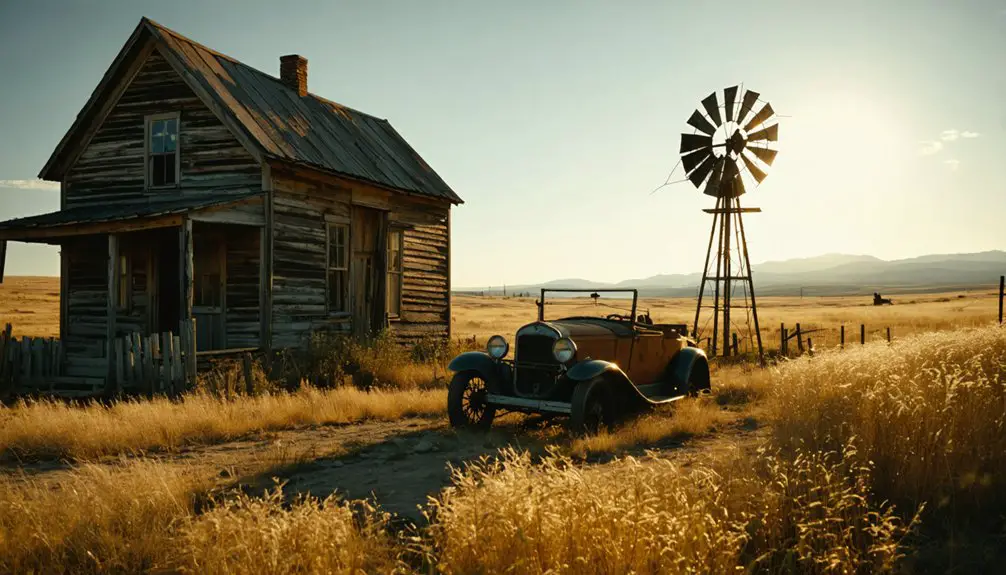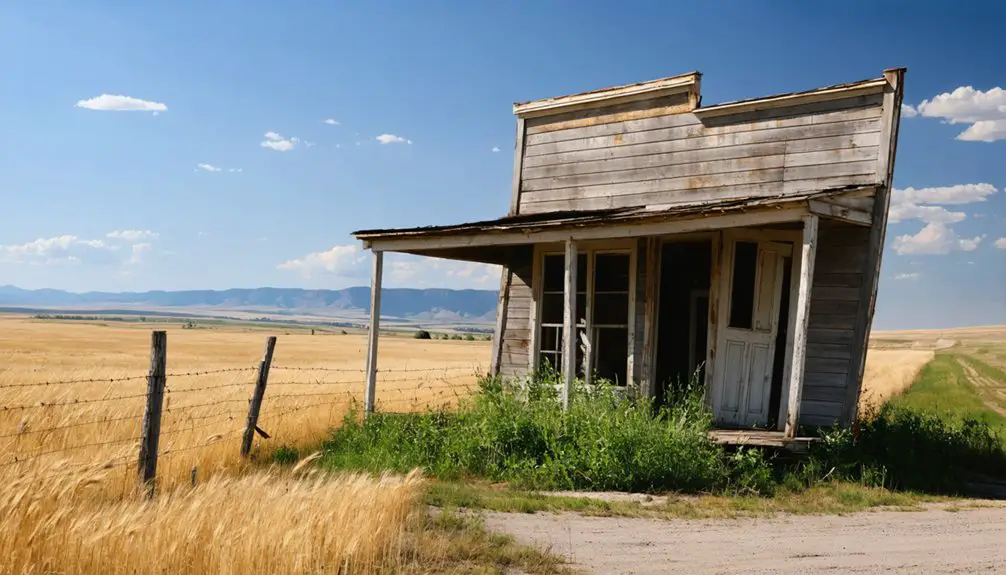You’ll find Comertown in northeastern Montana, established in 1913 along the Minneapolis, St. Paul & Sault Ste. Marie Railroad line. The town quickly grew into a crucial wheat shipping hub with two grain elevators, supporting local farmers who traveled from as far as the Canadian border. While it thrived through the late 1910s, agricultural decline and market depression led to its abandonment, marked by the post office’s closure in 1957. The remaining structures and Comer Park hold fascinating tales of Montana’s homesteading era.
Key Takeaways
- Founded in 1913, Comertown flourished as an agricultural hub but declined in the 1920s due to poor soil conditions and market depression.
- The closure of the post office in 1957 marked a significant milestone in Comertown’s transition to ghost town status.
- Few original structures remain today, with George Onstad’s grain elevator being one of the most notable surviving buildings.
- The Julio family’s private ownership helps protect the remaining historical structures from vandalism and deterioration.
- The town’s legacy continues through preserved structures and community stories, representing broader patterns of rural depopulation in northern Montana.
The Birth of a Railroad Town
While northeastern Montana’s landscape was once dominated by cattle drives in the 1880s, Comertown emerged in 1913 as a promising homestead community in Sheridan County.
From cattle country to homestead haven, Comertown’s 1913 founding marked a new chapter in Sheridan County’s agricultural story.
The Minneapolis, St. Paul & Sault Ste. Marie Railroad’s decision to build a branch line through the northern part of town sparked rapid development, transforming this grid-planned settlement into a bustling agricultural hub. Like its neighbor Whitetail, the town experienced a population surge after the railroad’s arrival.
You’ll find that railroad influence shaped every aspect of early Comertown. The town’s original six blocks along Main Street quickly expanded with Comer’s Addition, while the railroad’s right-of-way hosted essential industrial lots.
During the agricultural boom, two grain elevators – George Onstad’s in 1913 and The Farmers Elevator by 1916 – established Comertown as a significant wheat shipping point, connecting local farmers to regional markets. Early success in the grain trade was demonstrated when Jess Cook and Guy Harris sold the first load of wheat at $2.28 per bushel.
Peak Years and Community Growth
The peak years of Comertown unfolded during the late 1910s to early 1920s as the town flourished into a vibrant agricultural hub.
You’d have found two bustling grain elevators handling the region’s harvests, with farmers streaming in from as far as the Canadian border. Agricultural trends drove community expansion, evident in the well-built homes with manicured yards that dotted the town’s gridded streets.
Local businesses thrived, anchored by George Onstad’s lumber yard and C.J. Severson’s hardware store. The town’s success caught the attention of residents from Sheridan County, which encompassed multiple similarly named jurisdictions across different states.
You could’ve stayed at one of two hotels, dined at several restaurants, or watched the constant activity at the Livery Barn during harvest season.
The establishment of a post office, school, and cemetery marked Comertown’s transformation into a permanent settlement, showcasing the community’s confidence in its future.
Daily Life in Early Comertown
Daily rhythms in early Comertown revolved around farming’s seasonal demands, with residents adapting to harsh prairie conditions through communal support.
You’d find daily routines centered around the town’s essential services, where the post office served as a hub for news and connection while the boarding house provided shared cooking and bathroom facilities.
Much like Comet City residents who earned $3 per day mining silver, Comertown’s farmers worked tirelessly for modest wages to sustain their families.
Community gatherings were the heartbeat of social life, and you could experience them through:
- Monthly community club meetings, held outdoors in summer and in homes during winter
- Ice cream socials and talent shows that raised funds while building neighborly bonds
- Annual Memorial Day events that brought everyone together for town cleanup and picnics in Comer Park
The railroad’s 1913 arrival transformed these routines, connecting residents to wider markets and opportunities.
Today, only a rock with plaque remains to mark where this once-vibrant community stood.
Notable Buildings and Architecture
You’ll find few original structures still standing in Comertown’s historic business district, though building foundations offer clues to the town’s commercial past.
The first grain elevator, built by George Onstad, established Comertown’s connection to Montana’s agricultural economy and rail transport network.
Similar to Fort Maginnis, the town employed skilled craftsmen to construct its essential buildings and facilities.
Rostad’s store, which handled groceries, hardware, and dry goods while doubling as the post office, exemplified the multi-purpose commercial buildings that once lined the town’s unpaved streets.
Like many Montana ghost towns that housed up to 3,000 miners during peak operations, Comertown’s buildings tell the story of a once-thriving community.
Railroad Buildings Remain
Railroad heritage dominates Comertown’s remaining structures, anchored by two historic grain elevators that served the Minneapolis, St. Paul, & Sault Ste. Marie Railroad.
You’ll find remarkable architectural significance in these surviving buildings, which showcase the region’s agricultural rail legacy from 1913. Like many rural communities in Sheridan County’s history, Comertown has experienced significant decline and now approaches ghost town status. Similar to the shift seen in modern architecture throughout Northeast Montana, many of the town’s original storefronts were modified with metal sheathing between the 1960s and 1980s.
The railroad’s impact on Comertown’s development remains visible through:
- The primary elevator with its original Fairbanks-Morse scale and distinctive “OCCIDENT ELEVATOR” lettering
- A secondary wood-crib elevator featuring clapboard siding and monitor roof, later modified with corrugated metal
- A small wood-framed office building covered in metal sheeting that simulates brick, housing both administrative and electrical equipment spaces
Railroad preservation efforts have helped maintain these structures, though they’re increasingly rare examples of early 20th-century transport architecture in Montana’s forgotten railroad towns.
Historic Business District Features
Though less ornate than neighboring Montana towns, Comertown’s historic business district features practical wood-frame commercial buildings that exemplify early 20th-century rural architecture.
You’ll find simple yet functional structures clad in clapboard siding, with the Occident Elevator standing as the district’s most prominent landmark. Unlike Lewistown’s buildings with their stone and terra cotta architectural details, Comertown’s structures embrace simplicity.
The business district’s commercial architecture emphasizes utility over style, featuring an office building with plank exterior and metal sheeting designed to simulate brick.
A distinctive Fairbanks-Morse scale indicates the town’s deep connection to agricultural commerce.
While nearby districts showcase elaborate Beaux-Arts and Neoclassical designs with terra cotta ornamentation, Comertown’s buildings maintain a straightforward appearance with practical elements like monitor roofs and brick chimneys, reflecting its role as a modest but essential agricultural hub.
The Post Office Era

From its founding in 1914 until 1957, you’d find Comertown’s post office serving as the heart of the community, processing mail through multiple postmasters including W.R. Vezina, Clayton Comer, W.J. Thoreson, and the Rostads.
You could watch the daily rhythm of postal operations integrate seamlessly with the Soo Line Railroad‘s transport of mail and goods, which generated $32,000 in business by 1916.
The final chapter of postal service closed when Mrs. Rostad, who succeeded her husband Martin’s 32-year tenure, turned off the lights one last time in June 1957, shifting mail delivery to a rural route from Westby.
Mail Service Daily Operations
When the Comertown post office opened its doors in 1915, Postmaster W.R. Vezina faced daily challenges with mail sorting and distributing essential community supplies.
You’d find the small office bustling with activity as it served as the lifeline between local farmers and the outside world.
Here’s what you’d experience at the post office during its peak:
- Mail clerks battling with hard-to-read handwriting while ensuring letters didn’t get mixed up with similarly named towns
- Regular shipments of agricultural supplies arriving via the Soo Line railroad, keeping local farms operational
- Daily coordination between postal workers and railroad personnel to maintain smooth flow of mail and goods
When young Clayton Comer wasn’t helping Vezina manage operations, you’d find the post office working closely with local businesses, processing mail that supported the region’s $32,000 worth of railroad commerce in 1916.
Last Postal Worker Memories
As the final chapter of Comertown’s postal service drew near, Mrs. Rostad stepped into her role as the last postal worker, carrying forward her husband Martin’s legacy of over three decades of service.
You’ll find her memories shared through the physical remnants of the post office era, marked now by foundations and historic plaques that dot the landscape.
When you visit today, you can imagine her final acts of service on June 29, 1957, as she applied the last “Comertown” postmark – now a cherished collectible that captures the end of an era.
Her tenure represented more than just mail delivery; it marked the conclusion of a crucial community hub that had connected local farmers and businesses since 1915, before rural route delivery from Westby took over.
Community Hub Until 1957
The establishment of Comertown’s post office in 1915 marked the beginning of an essential community hub that would serve northeastern Montana’s farmers and merchants for over four decades.
You’ll find the spirit of independence thrived here, as postal services kept the town connected to the wider world while fostering local community gatherings.
Here’s how this crucial institution supported Comertown’s growth:
- It anchored $32,000 worth of commerce with the Soo Line Railroad by 1916.
- You’d find it serving as the heart of local communication, alongside retail shops and the railroad depot.
- It maintained the town’s identity through the 1920s despite regional agricultural changes.
Until its closure in 1957, the post office remained Comertown’s lifeline, symbolizing the town’s resilience against the shifting tides of rural Montana life.
Economic Changes and Population Shifts

During Montana’s late 19th-century mining boom, Comertown’s economic fortunes rose and fell dramatically with the region’s silver market. The mining economy drew over 1,500 prospectors in 1867 alone, triggering rapid development of housing and businesses to serve the growing population.
You’d have seen hotels, banks, and breweries spring up to support the influx of skilled laborers and investors.
But when silver prices crashed in the late 1880s, Comertown’s population dynamics shifted sharply. The Sherman Silver Purchase Act provided temporary relief, but couldn’t prevent the inevitable decline.
As mining profits dwindled and easily accessible deposits were exhausted, workers left to seek opportunities elsewhere. Buildings were abandoned, real estate values plummeted, and the town’s vibrant community gradually faded into ghost town status.
Ghost Town Status and Preservation
Today’s preservation efforts in Comertown stand in stark contrast to its late 19th-century decline. Like other Montana ghost towns, it’s benefited from the state’s growing focus on ghost town preservation and community engagement initiatives pioneered by organizations like the Montana Ghost Town Preservation Society since 1969.
Montana’s ghost towns find new life through preservation societies, transforming forgotten places into protected windows into the past.
You’ll find these key preservation approaches in action:
- Structural stabilization projects to protect original buildings from weather damage and vandalism
- Educational programs featuring interpretive signage and oral history collection from descendants
- Grant-funded maintenance efforts combined with visitor management strategies to protect historic integrity
While not as extensively developed as sites like Bannack or Garnet, Comertown’s preservation follows similar principles of protecting Montana’s cultural heritage through careful stewardship and public education.
Historical Significance in Montana

Representing a quintessential early 20th-century agricultural frontier settlement, Comertown exemplifies northeastern Montana’s dryland farming expansion during the homesteading era.
You’ll find its cultural significance preserved in the well-maintained town park and remaining structures that offer a genuine window into Montana’s agricultural heritage. The town’s grid layout, complete with unpaved streets and platted blocks, stands as a proof of the region’s railroad town development.
What makes Comertown particularly valuable is its high degree of site integrity, maintaining an authentic “historic feel” that’s increasingly rare.
As you explore the town’s landscape, you’ll discover how it mirrors the broader story of Montana’s boom-bust cycle, where railroad-dependent farming communities rose and fell with changing transportation patterns and agricultural fortunes.
Exploring the Ruins Today
Visitors approaching Comertown’s ruins will find a remote prairie landscape accessible only by gravel and dirt roads that demand high-clearance vehicles.
You’ll discover abandoned structures reduced to skeletal frames, with collapsed log cabins and mining debris scattered across the terrain. The site’s isolation creates an intimate connection to Montana’s mining heritage, though you’ll need to navigate carefully around unstable remnants.
For the finest exploration experience:
- Visit during summer or early fall when weather conditions are ideal
- Bring essential supplies and water since no facilities exist on-site
- Stick to external viewing of structures, as interiors aren’t safe to enter
While most buildings have succumbed to time, you can still spot partial walls of the old butcher’s residence and pre-1892 homes amid the prairie’s natural reclamation.
Legacy and Cultural Impact
You’ll find Comertown’s enduring memory preserved through the stories of former residents who recall its heyday as a bustling Soo Line railroad stop and agricultural hub in Sheridan County.
The town’s economic influence stretched beyond its physical boundaries, serving hundreds of Montana settlers with essential grain storage and rail shipping services throughout the early 20th century.
As one of Montana’s most evocative ghost towns, Comertown represents the broader pattern of rural depopulation that transformed the northern plains, leaving behind tangible reminders of the region’s railroad and farming heritage.
Historical Community Memory Lives
Though Comertown’s physical structures have largely succumbed to time, the town’s legacy endures through dedicated preservation efforts and community remembrance.
You’ll find the town’s cultural preservation evident in three distinct ways:
- The Julio family’s private ownership of buildings helps protect what remains from vandalism, maintaining community identity through careful stewardship.
- A memorial boulder placed in 2005, though weather-worn, stands as a symbolic tribute to the town’s significance.
- Annual Memorial Day gatherings featuring community clean-ups and picnics keep collective memory alive.
The unpaved streets and historic grid layout still whisper stories of frontier life, while Comer Park, named for a local social pioneer, remains a hallmark of the strong bonds that once defined this northeastern Montana homestead community.
Railroad Town Economic Impact
When the Minneapolis, St. Paul & Sault Ste. Marie Railroad laid tracks through Comertown in 1913, you’d have witnessed the birth of a quintessential railroad town.
The Soo Line’s arrival transformed this Montana outpost into a bustling agricultural hub, where grain elevators sprouted alongside the tracks and wheat prices hit $2.28 per bushel.
You can trace Comertown’s railroad economics through its grain elevators – Onstad’s first elevator, the Farmers elevator, and the Occident elevator – which served as the town’s economic backbone.
But by the 1920s, agricultural decline set in as poor soil conditions and market depression took their toll. The railroad-dependent economy couldn’t sustain itself, and by 1957, even the post office closed.
Today, Comertown stands as a ghost town, its abandoned rail corridor a reflection of the rise and fall of railroad-driven frontier development.
Montana’s Ghost Town Heritage
As abandoned settlements dot Montana’s landscape, they serve as living museums of the state’s pioneering spirit and mineral wealth pursuits. Through preservation efforts and ghost town tourism, you’ll discover authentic 19th-century structures that tell stories of community resilience and social dynamics during the mining era.
These sites reveal the environmental impact of resource extraction while showcasing historical mining techniques.
Experience Montana’s cultural heritage through:
- Living history museums featuring historical reenactments at places like Virginia City
- Original buildings and mining infrastructure that showcase economic trends from boom to bust periods
- Guided tours sharing oral histories of diverse frontier residents, from miners to merchants
These protected landmarks embody the complex social fabric that shaped Montana’s identity, preserving tales of hardship, innovation, and determination for future generations.
Frequently Asked Questions
Are There Any Documented Supernatural Occurrences or Ghost Stories From Comertown?
You won’t find documented supernatural sightings or local legends from this location, as historical records focus on the town’s physical decline and preservation needs rather than paranormal activity or ghostly encounters.
What Happened to the Original Town Records and Documents?
With over 90% of Montana ghost town records lost to time, you’ll find Comertown’s original documents are missing archives – destroyed when civic buildings were demolished and through decades without historical preservation efforts.
Did Any Famous People Ever Visit or Live in Comertown?
You won’t find any famous visitors in Comertown’s history – records show only local legends and community members like the Julio family and Clayton Comer shaped the town’s modest agricultural story.
What Was the Average Property Value During Comertown’s Peak Years?
You can’t find exact historical real estate trends for Comertown’s peak period (1913-1920s), though property values would’ve risen with agricultural prosperity before plummeting during the region’s economic downturn.
Were There Any Significant Crimes or Notable Legal Cases in Comertown?
Ever wonder what secrets small towns hold? You won’t find any unsolved mysteries or historical controversies here – no significant crimes or notable legal cases have been documented during Comertown’s inhabited years.
References
- https://www.youtube.com/watch?v=YU0y9_5Ylbg
- https://montanahistoriclandscape.com/2013/06/07/soo-line-towns-in-sheridan-and-daniels-counties/
- https://963theblaze.com/montana-ghost-town-saved-last-minute-rescue-halts-foreclosure/
- http://sites.rootsweb.com/~mtscdgs/comertown.html
- https://npgallery.nps.gov/GetAsset/c57c46e0-4ec0-4978-8c07-c1c37dd92811
- https://landingaday.wordpress.com/2015/03/27/whitetail-dooley-and-comertown-montana/
- https://en.wikipedia.org/wiki/Comertown
- https://en.wikipedia.org/wiki/Sheridan_County
- https://montana.hometownlocator.com/mt/sheridan/comertown.cfm
- https://www.youtube.com/watch?v=wxA0j_uX7qg



